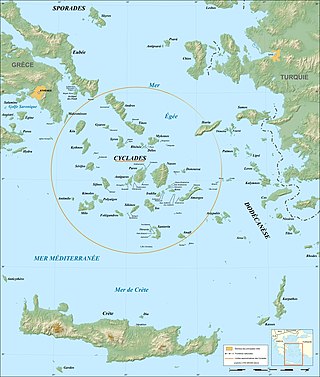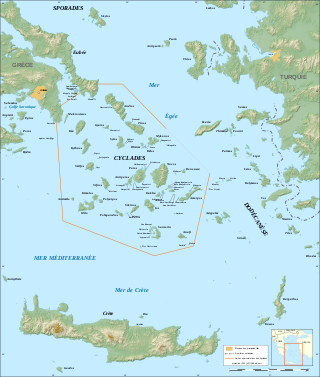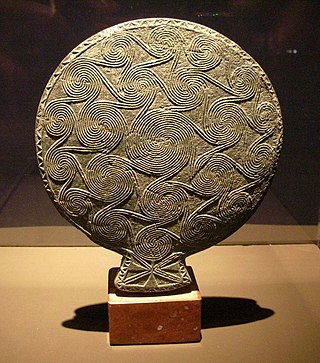The use of metal became widespread during this period. In all the settlements there were found grave goods in the form of daggers, and also tools such as chisels, tweezers and fishhooks. Also fibulae (brooches) were made of bronze and silver.
Keros-Syros culture is clearly seen as the successor of Grotta-Pelos.
The trade relations of Keros-Syros culture are widespread. They range from the Greek mainland to Crete, where the Cycladic figurines were exported, and imitated by the local artists. Also, the trade went as far as the Asia Minor. Finds at Troy, in the periods of Troy I and Troy II, were also made.

Aegean civilization is a general term for the Bronze Age civilizations of Greece around the Aegean Sea. There are three distinct but communicating and interacting geographic regions covered by this term: Crete, the Cyclades and the Greek mainland. Crete is associated with the Minoan civilization from the Early Bronze Age. The Cycladic civilization converges with the mainland during the Early Helladic ("Minyan") period and with Crete in the Middle Minoan period. From c. 1450 BC, the Greek Mycenaean civilization spreads to Crete, probably by military conquest. The earlier Aegean farming populations of Neolithic Greece brought agriculture westward into Europe before 5,000 BC.

The Cyclades are an island group in the Aegean Sea, southeast of mainland Greece and a former administrative prefecture of Greece. They are one of the island groups which constitute the Aegean archipelago. The name refers to the archipelago forming a circle around the sacred island of Delos. The largest island of the Cyclades is Naxos, however the most populated is Syros.

Milos or Melos is a volcanic Greek island in the Aegean Sea, just north of the Sea of Crete. Milos is the southwestern-most island in the Cyclades group.

Syros, also known as Siros or Syra, is a Greek island in the Cyclades, in the Aegean Sea. It is 78 nautical miles (144 km) south-east of Athens. The area of the island is 83.6 km2 (32 sq mi) and at the 2021 census it had 21,124 inhabitants.

Cycladic culture was a Bronze Age culture found throughout the islands of the Cyclades in the Aegean Sea. In chronological terms, it is a relative dating system for artifacts which serves as a roughly contemporary dating system to Helladic chronology and Minoan chronology (Crete) during the same period of time.

Helladic chronology is a relative dating system used in archaeology and art history. It complements the Minoan chronology scheme devised by Sir Arthur Evans for the categorisation of Bronze Age artefacts from the Minoan civilization within a historical framework. Whereas Minoan chronology is specific to Crete, the cultural and geographical scope of Helladic chronology is confined to mainland Greece during the same timespan. Similarly, a Cycladic chronology system is used for artifacts found in the Aegean islands. Archaeological evidence has shown that, broadly, civilisation developed concurrently across the whole region and so the three schemes complement each other chronologically. They are grouped together as "Aegean" in terms such as Aegean art and, rather more controversially, Aegean civilization.

Frying pans is the descriptive nickname for a type of Early Cycladic II artifacts from the Aegean Islands around 2700-2200 BCE. They are flat circular disks with a "handle", and usually made from earthenware, but sometimes stone. They are found especially during the Cycladic Grotta-Pelos and Keros-Syros cultures. Their purpose remains unknown, although they are usually interpreted as prestige goods.

Keros is an uninhabited and unpopulated Greek island in the Cyclades about 10 km (6 mi) southeast of Naxos. Administratively it is part of the community of Koufonisia. It has an area of 15 km2 (6 sq mi) and its highest point is 432 m (1,417 ft). It was an important site to the Cycladic civilization that flourished around 2500 BC. It is now forbidden to land in Keros.

The ancient Cycladic culture flourished in the islands of the Aegean Sea from c. 3300 to 1100 BCE. Along with the Minoan civilization and Mycenaean Greece, the Cycladic people are counted among the three major Aegean cultures. Cycladic art therefore comprises one of the three main branches of Aegean art.

The Cyclades are Greek islands located in the southern part of the Aegean Sea. The archipelago contains some 2,200 islands, islets and rocks; just 33 islands are inhabited. For the ancients, they formed a circle around the sacred island of Delos, hence the name of the archipelago. The best-known are, from north to south and from east to west: Andros, Tinos, Mykonos, Naxos, Amorgos, Syros, Paros and Antiparos, Ios, Santorini, Anafi, Kea, Kythnos, Serifos, Sifnos, Folegandros and Sikinos, Milos and Kimolos; to these can be added the little Cyclades: Irakleia, Schoinoussa, Koufonisi, Keros and Donoussa, as well as Makronisos between Kea and Attica, Gyaros, which lies before Andros, and Polyaigos to the east of Kimolos and Thirassia, before Santorini. At times they were also called by the generic name of Archipelago.

Phylakopi, located at the northern coast of the island of Milos, is one of the most important Bronze Age settlements in the Aegean and especially in the Cyclades. The importance of Phylakopi is in its continuity throughout the Bronze Age and because of this, it is the type-site for the investigation of several chronological periods of the Aegean Bronze Age.

The Cycladian frying pan is an ornately decorated stone object of the type nicknamed as frying pans, from the Bronze Age Cycladic civilization. It dates to the Early Cycladic period, between the 27th and 24th centuries BC. The find spot is unknown, except that it originated on the Cycladic island of Naxos. The item derived from an illegal excavation and was acquired in 1975 by the Baden State Museum in Karlsruhe. On 6 June 2014 it was repatriated to the National Archaeological Museum of Athens, Greece.
The Lesser Cyclades or Small Cyclades is an island complex in the Aegean Sea, inside the archipelago of the Cyclades. It is located to the south-east of Naxos and comprises 32 islands and rocks. The main islands are Ano Koufonisi, Kato Koufonisi, Irakleia, Schoinoussa, Donousa and Keros. The largest of them is Irakleia with an area of 18 km2 and the most populated is Ano Koufonisi with a population of 399, according to the 2011 census. Only four of them are inhabited, Ano Koufonisi, Irakleia, Donousa and Schoinoussa. The islet of Kato Antikeri has also two inhabitants. Administratively, the islands belong to the Naxos and Lesser Cyclades municipality apart from the islets of Ano and Kato Antikeri that belong to Amorgos municipality.

Skarkos is an early Bronze Age settlement on the island of Ios in Greece. Owing to its well preserved state, Skarkos is one of the most important prehistoric sites in the Aegean and especially the Cyclades.
Markiani is a Bronze Age fortified settlement built on top of a hill in the island of Amorgos in Greece.
Chalandriani is a major early Bronze Age cemetery on the island of Syros in Greece, dated to the Early Cycladic II period. The fortified prehistoric settlement of Kastri is located north of Chalandriani. Chalandriani was first excavated by the Greek classical archaeologist Christos Tsountas in 1898.

The Grotta-Pelos culture (Greek: Γρόττα-Πηλός) refers to a "cultural" dating system used for part of the early Bronze Age in Greece. Specifically, it is the period that marks the beginning of the so-called Cycladic culture and spans the Neolithic period in the late 4th millennium BC (ca. 3300 BC), continuing in the Bronze Age to about 2700 BC. The term was coined by Colin Renfrew, who named it after the sites of Grotta and Pelos on the Cycladic islands of Naxos and Milos, respectively. Other archaeologists prefer a "chronological" dating system and refer to this period as the Early Cycladic I (ECI).
The Kastri culture refers to a "cultural" dating system used for the Cycladic culture that flourished during the early Bronze Age in Greece. It spans the period ca. 2500–2200 BC and was named by Colin Renfrew, after the fortified settlement of Kastri near Chalandriani on the Cycladic island of Syros. In Renfrew's system, Kastri culture follows the Keros-Syros culture. However, some archaeologists believe that the Keros-Syros and Kastri cultures belong to the same phase. Others describe this period as the Early Cycladic III (ECIII).

The Phylakopi I culture refers to a "cultural" dating system used for the Cycladic culture that flourished during the early Bronze Age in Greece. It spans the period ca. 2300-2000 BC and was named by Colin Renfrew, after the settlement of Phylakopi on the Cycladic island of Milos. Other archaeologists describe this period as the Early Cycladic III (ECIII).

Saliagos is an islet in the Greek island group of Cyclades. It is the first early farming site and one of the oldest settlements of the Cycladic culture.
















